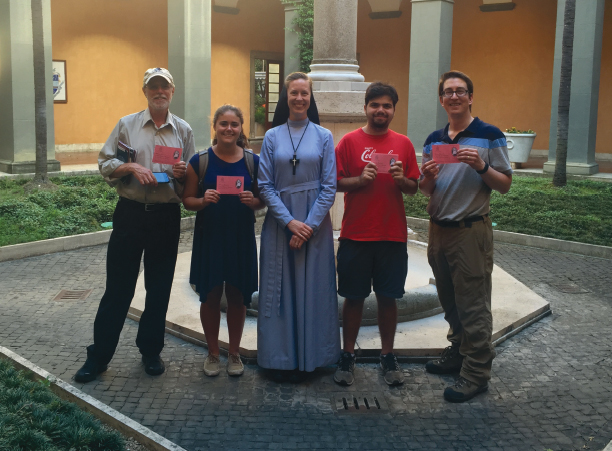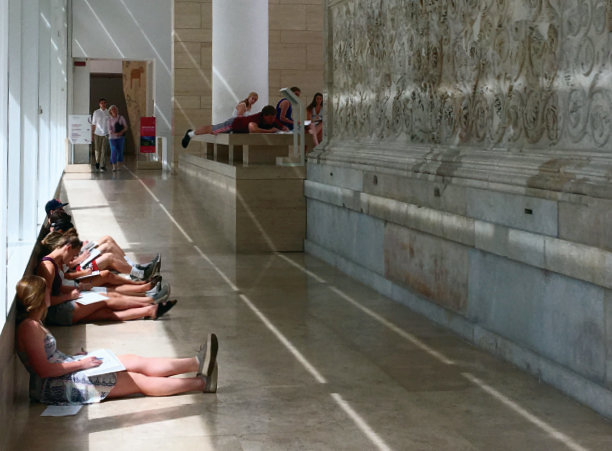"It ended up being crucial to my work," he says. "If I hadn't been with them, I never would have seen it."
Holy Cross' Maymester Program, for which faculty teams lead students abroad for a four- to six-week, experiential-learning study abroad trip, can be transformative in the lives of students. And the experience can be just as exciting and enriching for professors, who see familiar sights with a fresh perspective and make connections through the enthusiasm of their students.
"Most of these things I have seen before numerous times," says Professor Thomas Martin, the Jeremiah W. O'Connor, Jr., Chair in the Classics, who co-taught the Maymester course Rome in History and Imagination with Seider. "To learn something new you have to talk aloud and move your body. By having to talk to students and explain to them anew, it sets me up for more creative thoughts."
Other Maymester courses this year explored social justice in Bangalore, India; the history of the Holocaust in Central Europe; theatre in London; and revolutionary Paris. In some, faculty have been able to conduct their research on the side — as Martin did when he spent an afternoon in the Vatican Library this past May. But such direct research is not the focus for faculty.
"I am not talking about things that necessarily directly advance my research agenda, though that does happen," he says. Rather, the experience of returning to Rome with students reminds him of the excitement of his own first trip to the Eternal City 50 years ago. "Going there, it was like an incredible sensory banquet, in which I never got full — and I am still hungry to see more," he says, noting with a laugh that the metaphor is particularly apt for Italy. "Every time I go, I feel cognitively nourished."
As with many Maymester programs, Martin and Seider's course goes beyond exploring the history of the area to examine how that history resounds to the present day. In that regard, Rome may be one of the greatest cities in the world for experiential learning.
"The Roman Forum and the Palatine Hill are right in the middle of a major urban metropolis, and yet you don't have to walk far to see monuments from the Second World War or the Fascist era," Martin says. "The architectureand art are living together like a giant intellectual bio-dome."
 Thomas Martin, Rachel Marasco '18, Steven Paganelli '19 and Aaron Seider stand with Sister Maria, of the Bishops' Office for United States Visitors to the Vatican, displaying their tickets for an upcoming papal audience with Pope Francis in St. Peter's Square.
Thomas Martin, Rachel Marasco '18, Steven Paganelli '19 and Aaron Seider stand with Sister Maria, of the Bishops' Office for United States Visitors to the Vatican, displaying their tickets for an upcoming papal audience with Pope Francis in St. Peter's Square."You can see the lights going on," Martin continues. "This would have been decorated or people would have gathered here — they are able to see human life and human interaction taking place in their minds. You can't do that by reading a text or looking at something on screen."
At the same time, the professors are able to make similar connections they would never make in their research in the library. During past Maymesters, for example, Seider was in the midst of researching poems about the legendary Roman general Marcellus, and as he walked around the city with students, he found himself constantly noticing statues and buildings dedicated to the ancient hero. "I began more and more to understand the context of this literature and see how the buildings were part of this conversation," Seider says. Coming back to Holy Cross, he is now more apt to put up maps of Rome during class to illustrate the discussion, he says: "It enriches the context of everything."
Martin has similarly begun to work more material from Maymester into his academic-year courses, using it to bring the classics alive for modern times. For a course on Alexander the Great, for example, he shows students how Alexandrian imagery was appropriated by Italian fascists in their monuments.
 Taking advantage of the opportunity to study firsthand one of the most crucial monuments of ancient Rome, students sketched scenes from Augustus' Altar of Peace. Photo by Thomas Martin
Taking advantage of the opportunity to study firsthand one of the most crucial monuments of ancient Rome, students sketched scenes from Augustus' Altar of Peace. Photo by Thomas MartinIn addition to learning from their students and the city itself, the professors have also learned from each other. Maymester is unique in giving professors such intimate exposure to one another's work. "It was a real treat to sit at the back of one of Tom's lectures," Seider says. "Once he got going on this one poem, there was no slowing him down; I was just on the edge of my seat. I said, look at what he does and how he connects with students."
Beyond such formal presentations, having the luxury of a multiweek excursion gives faculty time for more casual conversations they don't always have time for on campus. "It's like being two pilots in the front of an airplane — you are really in close quarters" Martin says. "Now imagine it's a 30-day flight and you never are able to get off the plane, and all the passengers need to be educated, entertained and kept safe."
Far from being a burden, however, those tight quarters allowed the colleagues to carry on an ongoing conversation influenced by the richness of the Roman environment — whether it was pointing out an interesting feature of a church they passed or deciding together how they would interpret a new site for students.
"It's an unbelievable stimulus to creativity," Martin says. "Because we are locked in this cockpit together, you can think of something at night and you have someone to tell it to the next day who will be interested." And when the plane literally and figuratively landed back home, both professors arrived with a renewed sense of enthusiasm and new approaches for the classroom, inspired by the richness of Rome.
Written by Michael Blanding for the Fall 2018 issue of Holy Cross Magazine.
About Holy Cross Magazine
Holy Cross Magazine (HCM) is the quarterly alumni publication of the College of the Holy Cross. The award-winning publication is mailed to alumni and friends of the College and includes intriguing profiles, make-you-think features, alumni news, exclusive photos and more. Visit magazine.holycross.edu/about to contact HCM, submit alumni class notes, milestones, or letters to the editor.

